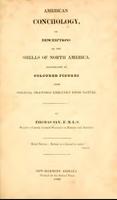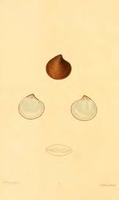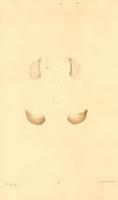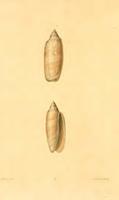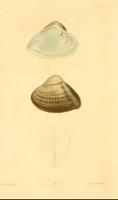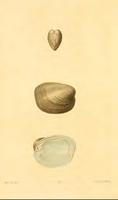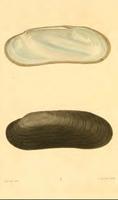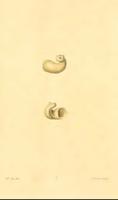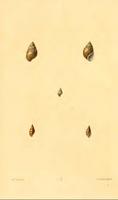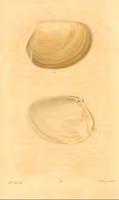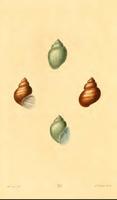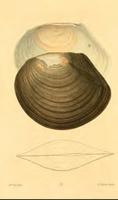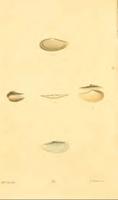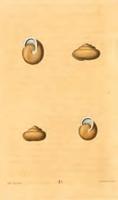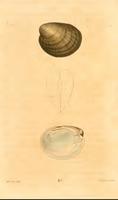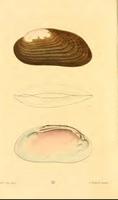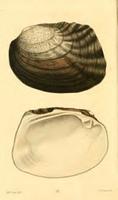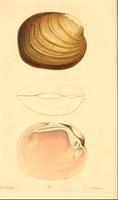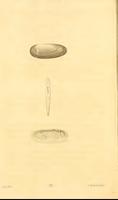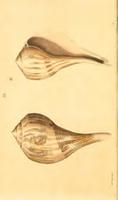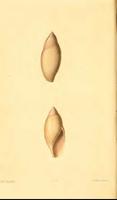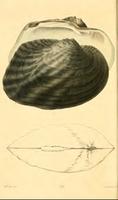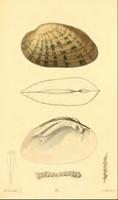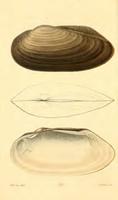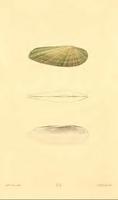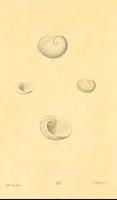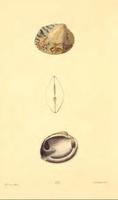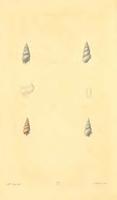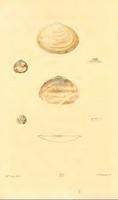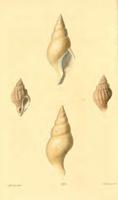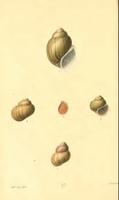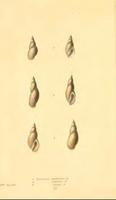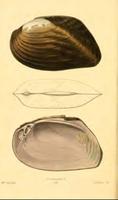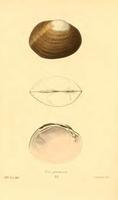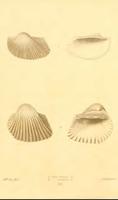Part 12. American Conchology (Thomas Say)
Cornelius Tiebout's move to New Harmony, Indiana and his earlier engravings in Philadelphia for volumes 1 and 2 of Thomas Say's American Entomology, together with his engravings in New Harmony for volume 3, are described in Part 11. Say is remembered as both "father of American entomology" and "father of American conchology", not only for first descriptions in journal articles, but also his book, American Conchology.
Tiebout engraved 33 plates in American Conchology, published at the School Press (also known as Maclure's Press) in New Harmony, 1830-1834. During those years, the book was published in parts marked No. I, No. II, up to No. VI. A final No. VII was published in Philadelphia in 1838, four years after Say's death in 1834. All the plates signed by Tiebout appear in the first four Nos. The last of these, No. IV, is dated March, 1832. According to records kept by Tiebout's descendants, he died on 24 February 1832. His son-in-law was administrator for his estate, with a court record dated 29 March 1832. (One of the four signers was Thomas Say.) The dates suggest that Tiebout's three plates in No. IV were his last signed engravings.
The conditions under which American Conchology was published led R. E. Banta to write of "the miracle of its production in the ague-ridden wilderness that was Indiana in the eighteen-thirties." ("The American Conchology: A Venture in Backwoods Book Printing", The Colophon: A Book Collectors' Quarterly vol. 3, no. 1, 1938, pp 24-40.) Online images of American Conchology are available:
Internet Archive
Internet Archive (different format; includes handwritten table of contents)
Hathitrust
In the table just below, the heading "A" represents a counting of species engraved by Tiebout; in some cases, there is more than one species on a plate. The heading "B" represents the No. in which the engraving appears. Each of the 33 plates shows the signatures of Mrs. Say as artist and C. Tiebout as engraver. A designation like "(Say, 1829)" means that Say first described the species—in an 1829 publication—and that the name he assigned to it is no longer the accepted name; the designation "Say, 1829" without parenthesis indicates that the name assigned by Say is the current accepted name.
| A | B | Plate | Name in American Conchology | Current scientific name | Common name |
|---|---|---|---|---|---|
| 1 | 1 | 1 | Astarte castanes | Astarte castanea (Say, 1822) | Chestnut astart |
| 2 | 1 | 2 | Pandora trilineata | Pandora trilineata Say, 1822 | Three-line pandora |
| 3 | 1 | 3 | Oliva literata | Oliva sayana sayana Ravenel, 1834 | Lettered olive (South Carolina State Shell) |
| 4 | 1 | 4 | Unio triangularis | Epioblasma triquetra (Barnes, 1823) | Sniffbox mussell |
| 5 | 1 | 5 | Unio ridibundus | Epioblasma obliquata (Rafinesque, 1820) | Purple cat's paw |
| 6 | 1 | 5 | Unio sulcatus | Epioblasma obliquata (Rafinesque, 1820) | Purple cat's paw |
| 7 | 1 | 6 | Unio monodonta | Margaritifera monodata (Say, 1829) | Spectaclecase |
| 8 | 1 | 7 | Delphinula laxa | (See Note 1 below.) | |
| 9 | 1 | 8 | Melania depygis | Lithasia obovata (Say, 1829) | Shawnee rocksnail |
| 10 | 1 | 8 | Melania nuperas | Lithasia verrucose (Rafinesque, 1820) | Varicose rocksnail |
| 11 | 1 | 9 | Anatina anatina, Spengler, 1802 | Lutraria lineata Say, 1822 | Smooth duckclam |
| 12 | 1 | 10 | Paludina decisa | Campeloma decisum (Say, 1817) | Painted campelona |
| 13 | 1 | 10 | Paludina vivipara | Viviparus viviparus (Linnaeus, 1758) | Common river snail |
| 14 | 2 | 11 | Anodonta suborbicutata | Utterbackia suborbiculata (Say, 1831) | Flat floater |
| 15 | 2 | 12 | Nucula concentrica | Saccella concentrica (Say, 1824) | Concentric nut clam |
| 16 | 2 | 12 | Nucula lævis | Yoldia lævis | (nut clam) |
| 17 | 2 | 12 | Nucula limatula | Yoldia limatula (Say, 1831) | File yoldia |
| 18 | 2 | 13 | Helix albolabris | Neohelix albolabris (Say, 1817) | White lip |
| 19 | 2 | 13 | Helix thyroidus | Mesodon thyroidus (Say, 1817) | White-lip globe |
| 20 | 2 | 14 | Unio ellipsis | Obovaria olivaria (Rafinesque, 1820) | Hickorynut |
| 21 | 2 | 15 | Unio subtentus | Ptycholbranchus sublentus (Say, 1825) | Fluted kidneyshell |
| 22 | 2 | 16 | Unio undulatus | Amblema plicata (Say, 1817) | Threeridge |
| 23 | 2 | 17 | Unio abruptus | Lampsilis abrupta (Say, 1831) | Pink mucket |
| 24 | 2 | 18 | Solecurtus costatus (See Note 2 below.) | ||
| 25 | 2 | 19 | Fulgur pyruloides | Fulguropsis pyroloides | Pear whelk |
| 26 | 2 | 20 | Glaudina truncata | Euglandina rosea (A. Férussac, 1821) | Rosy wolfsnail |
| 27 | 3 | 21 | Alasmodonta confragosa | Arcidens congragosus (Say, 1829) | Rock pocketbook |
| 28 | 3 | 22 | Unio phaseolus | Ptychobranchus fasciolaris (Rafinesque, 1820) | Kidney shell |
| 29 | 3 | 23 | Unio tetralasmus | Uniomerus tetralasama (Say, 1831) | Pondhorn |
| 30 | 3 | 24 | Unio dehiscens | Hemistena lata (Rafinesque, 1820) | Cracking pearlymussel |
| 31 | 3 | 25 | Sigaretus maculatus | Sinum maculatum (Say, 1831) | Brown baby ear |
| 32 | 3 | 25 | Sigaretus perspectivus | Sinum perspectivum (Say, 1831) | White baby ear |
| 33 | 3 | 26 | Venus grata | Venus Linnaeus, 1758 | Lady-in-waiting |
| 34 | 3 | 27 | Scalaria clathrus, var. b (See Note 3 below.) | ||
| 35 | 3 | 27 | Scalaria lineata | Gyroscala rupicola (Kurtz, 1860) | Brown-banded wentletrap |
| 36 | 3 | 27 | Scalaria multistriata | Epitonium multistriatum (Say, 1826) | (wentletrap) |
| 37 | 3 | 28 | Amphidesma transversum | Scrobicularia plana (de Costa, 1778) | Peppery furrow shell |
| 38 | 3 | 28 | Amphidesma æquale | Abra aequalis (Say, 1822) | Common Atlantic abra |
| 39 | 3 | 29 | Fusus cinereus | Urasalpinx cinerea (Say, 1822) | Atlantic oyster drill |
| 40 | 3 | 29 | Fusus corncus (See Note 4.) | ||
| 41 | 3 | 30 | Paludina intertexta | Callinina intertexta (Say, 1829) | Rotund mysterysnail |
| 42 | 3 | 30 | Paludina ponderosa | Campeloma crassulum Rafinesque, 1819 | Poderous campeloma |
| 43 | 3 | 30 | Paludina subpurpurea | Callinina subpurpurea (Say, 1829) | Olive mysterysnail |
| 44 | 4 | 33 | Unio interruptus | Plectomerus dombeyanus (Valenciennes, 1827) | Backclimber |
| 45 | 4 | 34 | Unio globulus | Glebula rotundata (Lamarck, 1819) | Round pearlshell |
| 46 | 4 | 36 | Arca lienosa | Anadara lienosa (Say, 1832) | (ark clam) |
| 47 | 4 | 36 | Arca staminea | Dallarca staminea (Say, 1832 | (ark shell) |
Notes 1-4 for the table above.
1. See Delphinula laxa.
2. Solecurtus is a genus of saltwater clams.
3. See Fossilworks.
4. This species may be related to Fusina Rafinesque, 1815.

The Tiebout family in New Harmony: Cornelius, Caroline, and Henry
Along with several mentions of Cornelius Tiebout in Josephine Marabella Elliott's Partners for Posterity: the Correspondence of William Maclure and Marie Duclos Fretageot, 1820-1833, Tiebout's daughter Caroline (1803-1878) is also mentioned:
Page 582: Caroline married printer Simon Kellogg in New Harmony on 24 February 1831. After her father's death in 1832, the family, including Caroline's brother, Henry Tiebout, moved to Wheelock, Texas.Page 892: "Caroline will also continue to work at coloring the Conchology and can make 2 dollars per week." (Fretageot to Thomas Say and William Maclure, 10 February 1831.)
Regarding Caroline Tiebout's assistance to Lucy Say in the coloring of plates, in a letter dated 30 July 1832, Thomas Say wrote to Marie Fretageot in Paris that "She [Lucy] has coloured five thousand plates of the Conchology since you left us, which is more than double the number she ever did before in the same time." (Workingmen's Institute Library, Collection I).Page 1100: A letter from Frédéric Auguste Ismar to Williams Maclure in Mexico, "Concerning the state of his School of Industry at New-Harmony, State of Indiana", lists Caroline Tiebout as one of five teachers in the school. The letter is dated 3 March 1830.
Further insights into the end of Cornelius Tiebout's career and the assistance provided by Henry Tiebout in the preparation of American Conchology is found in a letter that William Maclure received from Alexander Maclure (brother of William Maclure), with additions on page 4 written by Thomas Say. The letter can be viewed online: Indiana Memory, but some of the writing is hard to read. A portion dated 2 February 1831 is transcribed as follows:
If Mr. Tiebout should die, it will retard our proceedings; as Lyman Lyon cannot be supposed yet to be a good engraver, though he does pretty well, having engraved 3 simple plates without assistance for the Conchology, but he can not do a difficult plate. Lucy having little cooking to do has got through with a vast deal of colouring this winter, she has finished 2450 impressions with the aid of Henry Tiebout, but she will not be able to keep up.In another portion of the letter, positioned near the date 4 February, Say writes: "Mr. Tiebout is certainly very ill. I consider his life in much danger. His brother died lately in N.Y. He bequeathed him some property." The brother was Alexander Tiebout, who is mentioned in Part 3 as having been in business with Cornelius in New York City before 1800.
Online conchology resources:
WORMS - World Register of Marine Species
Shellers From the Past and the Present: Shellers From the Past and the Present. This site lists Thomas Say's conchology publications, and species he described, and species named after him.
Ian MacPhail and Marjorie Sutton, A Census of Copies of Thomas Say's American Conchology, from The Papers of the Bibliographical Society of America, Vol. 91, No. 1 (1997), pp. 51-64.
Lucy Say Illustrations at ANS Drexel
American Conchology site at ANS Drexel

